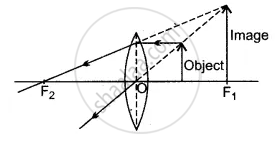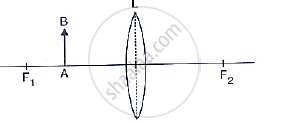Advertisements
Advertisements
प्रश्न
(i) Draw a ray diagram to show how the lens can be used as a ‘magnifying glass’? State the nature of the lens.
(ii) In what respect does the image in (i) above different from the image formed by a concave lens?
उत्तर
(i) The nature of the lens used is convex. The image formed is magnified, virtual, and upright. In this case, a convex lens is said to be used as a ‘magnifying glass.’

(ii) Image formed by a concave lens differs from the image in size. It is much smaller in size.
APPEARS IN
संबंधित प्रश्न
The following diagram shows an object AB and a converging lens L with foci F1 and F2 State three characteristics of the image in relation to the object.

A lens forms an erect, magnified, and virtual image of an object. Where is the object placed in relation to the lens?
Where is the object placed with respect to the principal focus of a magnifying glass, so as to see its enlarged image? Where is the image obtained?
Ray diagram for the formation of image by a magnifying glass.

If the magnification produced by a lens is - 0.5, the correct statement is ______.
The focal length of a convex lens is 25 cm. At what distance from the optical centre of the lens an object be placed to obtain a virtual image of twice the size?
The maximum magnifying power of a convex lens of focal length 5 cm can be ______.
Will the image formed by a magnifying glass be real or virtual?
A convex lens produces on a screen an image twice the size of the object. If the position of image and object be interchanged, what will be the magnification then?
An erect, magnified, and a virtual image is formed when an object is placed between the optical centre and principal focus of a lens.
(i) Name the lens.
(ii) Draw a ray diagram to show the formation of the image with the above-stated characteristics.
